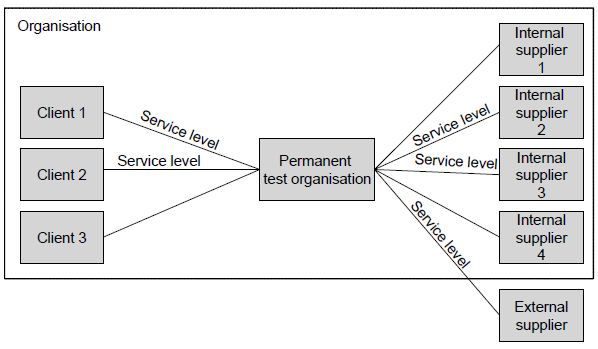The control centre’s role of the test organisation
A permanent test organisation can fulfil the role of control centre in setting up and maintaining test
environments. This should reduce costs and improve the quality for setting up and maintaining test environments. As a
control centre, the test organisation acts as the single point of contact for the clients of test environments. It is a
fixed point of contact for the client. The latter does not need to solve test environment-related problems himself. The
test organisation handles all internal and external contacts with the various suppliers of the (components of) test
environments. Service levels relating to the services procured from these suppliers can be agreed upon, as well as in
relation to the services offered by the test organisation (see figure 1 - Control centre’s role of the permanent
test organisation).
When an incident (problem) occurs in the test environment, the test organisation will have to solve it or have it
solved. By definition, the test organisation is the initial owner of the incident, until it becomes clear that the
cause is to be found elsewhere. By controlling the various processes (up to the production environment), incidents due
to other parties changing environments can be prevented. The test organisation needs to have a total picture of the
available components distributed across the various hardware and software configurations and any interfaces between
them. This will make it easier to determine and solve causes of incidents.

Figure 1: Control centre’s role of the permanent test organisation
The services offered by the test organisation need to be standardised. Only then will the benefits of central
maintenance and availability of test environments come to fruition. The availability of standard services translates to
offering a fixed set of possible test environments. This means that the demand of the client must always be translated
to one of these possible test environments. Here, the personnel of the test organisation act as an advisor.
One condition is that the employees providing the service need to have technical content-related knowledge of the test
environments. The organisation around this service is much more of a maintenance organisation than a test organisation.
Which also means that the employees’ profile must emphasise maintenance over testing.
Identifying test environments with service levels
What makes a system test environment a system test environment? At first sight it might seem an irrelevant question,
but it is extremely important in the light of the test organisation’s control centre role. Because what does it mean to
the client when the organisation offers a service called ‘setting up a system test environment’? Or what does the
client want when asking for an end-to-end test environment?
A test organisation may be responsible for delivering a service. Its highest responsibility is when services involve an
‘obligation to deliver results’. The permanent test organisation must deliver a result based on the request. The
delivery must occur within the pre-defined timeframe, at pre-defined costs, and at a pre-defined quality level. The
permanent test organisation is responsible for guaranteeing continuity in delivering the result. The standard for this
obligation is laid down in socalled service levels.
When a test organisation offers a service to set up a system test environment, the service can be rendered more
specific by using service levels. Service levels for test environments are defined by completing specific
characteristics of the environment. For instance:
-
Goal of the environment and test levels for which it can be used
-
The test environment’s target group
-
Interface with other systems or use of stubs and drivers
-
The test data in the environment and the refresh rate
-
The security requirements applying to the environment
-
The environment’s availability
-
Tooling available in the environment
-
Any entry and exit criteria.
|
